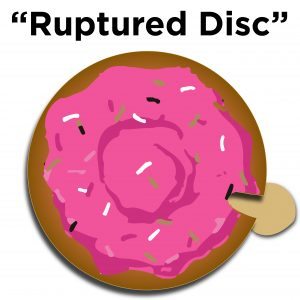What a Jelly Doughnut Can Teach You About Degenerative, Herniated, Bulging, & Ruptured Discs
Are you experiencing pain in your lower, middle, or upper back? While many common back injuries including curvature spine disorders (kyphosis, scoliosis, and lordosis), spinal stenosis, osteoporosis are easily understood, disc injuries can be a little harder to understand and decode.
The pain in your back might be caused by a disc injury such as herniated, bulging, degenerative, and ruptured. Now you might be thinking, how am I possibly going to distinguish between all of these confusing names and conditions? Luckily for you, we’re here to explain the difference between each condition by using the analogy of a jelly doughnut to help you better comprehend!
To start, you must understand what your discs are made of and what their main function is. Your spinal discs are composed of two parts: a tough outer portion, or the cake part of the doughnut, and a soft inner core, or the jelly filling part of the doughnut. The outside of your discs, or outer portion, consists of collagen fibers. While the inside of your discs, or inner core, consists of a network of fibers. These discs essentially perform as your shock absorbers in between your bones to help you walk, jump, run, or twist.

Next, we’re going to divide these conditions into two separate categories: one category including degenerative disc disease, and the other including bulging, herniated, and ruptured.
 Degenerative disc disease or DDD is actually not a disease at all, but rather just a result of your natural aging process. As you get older, your discs tend to break down and lose their water content. This loss results in your discs’ inability to act as your shock absorbers between your vertebrae bones. When looking at degenerative disc disease as a jelly doughnut, the jelly that was once inside your doughnut has now been lost and is simply just a plain, boring doughnut now.
Degenerative disc disease or DDD is actually not a disease at all, but rather just a result of your natural aging process. As you get older, your discs tend to break down and lose their water content. This loss results in your discs’ inability to act as your shock absorbers between your vertebrae bones. When looking at degenerative disc disease as a jelly doughnut, the jelly that was once inside your doughnut has now been lost and is simply just a plain, boring doughnut now.
You might be confused on why we categorize bulging, herniated, and ruptured disc under the same category. Well, the different conditions are essentially different stages of the same condition.
Stage 1: Bulging disc is when the jelly filling starts to push up against the outside cake layer.
-
Bulging discs occur when the disc pushes out of its normal position and begins to invade the space of your spinal nerves. The main difference between this stage and the other two is the wall of the disc doesn’t tear completely through yet.

Stage 2: Herniated disc or slipped disc is when the jelly starts to seep out through a crack in the outside cake layer.
-
Herniated discs occur when the wall starts to tear through, eventually resulting in the nucleus tearing (leaking) through the wall.

Stage 3: Ruptured disc is when the jelly has completely pushed through the outside cake layer.
- Occurs when the nucleus pushes completely outside of the disc. The fluid leaks out of the outside region, this is also known as a sequestered disc.

Hopefully, now you understand the difference between the common disc injuries. You most likely are probably also craving a delicious jelly doughnut. Go treat yourself for finally breaking down what you might be experiencing in your back by picking up a box of doughnuts!














